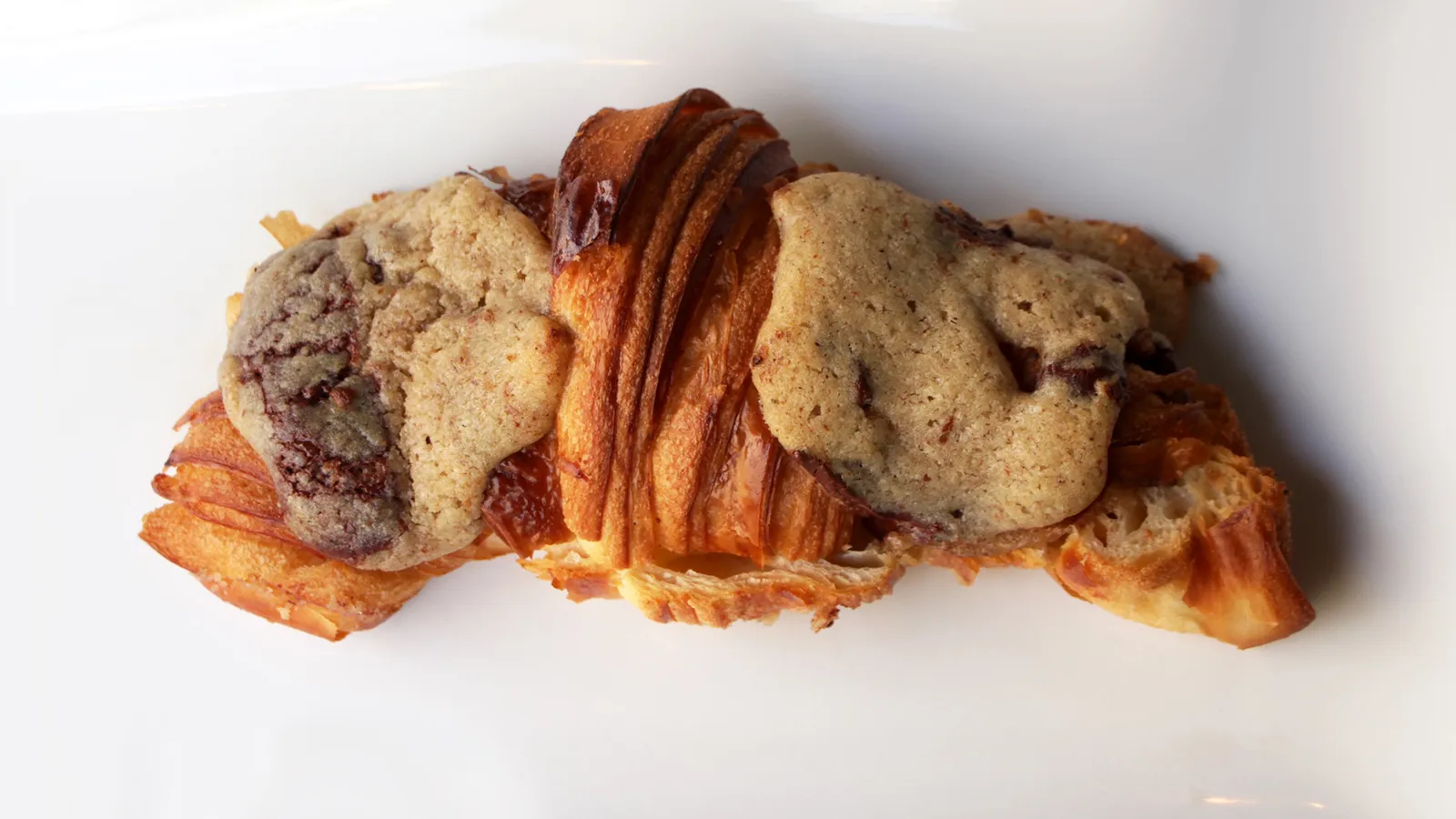The new croissant taking Paris by storm
The croissant has been reimagined into a host of portmanteau pastries, from the cruffin to the Cronut. Now its latest iteration, the "crookie", is taking Paris by storm.

There may be nothing as prototypically Parisian as a croissant, with its crispy golden exterior and tender layers of buttery bliss within. But take a look in any bakery case from New York to Melbourne these days, and you'll find the croissant has been contorted into a host of portmanteau pastries from the cruffin to the Cronut. Recently, Paris has even become home to its very own: a mashup of the croissant and the all-American chocolate chip cookie called the "crookie".
Such creations may seem irreverent, especially given French gastronomy's veneration of tradition. But given the complicated history of the country's most emblematic baked good, these franken-pastries are not as blasphemous as one might think.
The croissant's international origins hide in plain sight in any classic boulangerie (bakery). Neither pain (bread) nor pâtisserie (pastry), the croissant is technically a viennoiserie, a category of breakfast buns also home to the chocolate-stuffed pain au chocolat or chausson aux pommes, a "slipper" of puff pastry filled with apple compote. The category's name is a testament to its origins, not in Paris, but rather in Vienna.
Armchair historians paint a pretty picture of the croissant's birth during the Ottoman siege of the Austrian capital in 1683, and some even go so far as to give Marie Antoinette credit for bringing it to Paris. In reality, we have Vienna native August Zang to thank for the 1830's arrival of the proto-croissant, which he introduced to Parisians at his rue de Richelieu bakery, Boulangerie Viennoise. His Viennese pains de fantaisie – literally "fantasy breads" – stood out from Parisian offerings at the time, thanks to new leavening technology relying on fast-acting beer yeast rather than sourdough starter and to frequent enriching with butter, eggs, sugar or milk.
Parisians went gaga over the results, inspiring no shortage of imitators, especially of the kipferl, a yeasted pastry crescent enriched with butter. But while this Viennese specialty may have resembled a croissant in shape, its texture was a far cry from the characteristic flakiness that sees most croissant-eaters' chic scarves scattered with evidence of their breakfast.
A croissant is made using a technique called lamination, which sees a yeasted dough thrice "turned" or folded around sheets of butter, creating 27 layers of butter encased in 28 layers of dough. And laminating the croissant, according to Jim Chevallier, author of August Zang and the French Croissant, was a French idea, albeit by way of the Arab world, where lamination had already been in use since the 13th Century.
According to Patrick Rambourg, culinary historian and author of Histoire du Paris gastronomique: Du Moyen Age à nos jours (History of Gastronomic Paris: From the Middle Ages to Today), it wasn't until the late 19th Century that the word croissant would systematically be used to describe a yeasted dough laminated on a marble slab and folded into a croissant– the French word for crescent.
The croissant is thus fairly new on the French culinary landscape – and it's far from sacrosanct. Perhaps its most time-tested variation is the viennoiserie northern France dubs a pain au chocolat and southerners call a chocolatine: The dough wrapped around two bars of dark chocolate into a pillowy rectangle cannot justifiably be called a "chocolate croissant".
The word is nevertheless applied to other viennoiseries lacking the trademark curve. Croissants ordinaire (ordinary croissants) are characterized by their use of margarine, a cheaper, longer-lasting butter alternative invented in 1869 at the behest of Napoleon III. These days, most bakeries sell croissants ordinaires and croissants au beurre (butter croissants) side-by-side, with a price discrepancy of a few centimes and a slight difference in shape: To stand out from its vegetable fat-based brethren, the butter croissant is typically baked straight, looking less like a crescent than a rugby ball.
"Since a straight croissant is easier and quicker to make," explained Dominique Anract, president of the Confédération Nationale de la Boulangerie et Boulangerie-Pâtisserie Française (French National Confederation of Baking and Pastry), "and since we make many more butter ones than ordinary ones, often we make the butter one straight and the curved one ordinary, so that people can recognise them. Because otherwise, you can't tell just from looking."
The confederation discerns France’s very best butter croissants with an annual contest, pitting victors from each of France's 101 departments (administrative divisions grouping towns and communes) against one another first on the regional and then on the national stage. Lyon's Alexis Douine from Boulangerie Henri Gay was the 2023 winner and is France's reigning butter croissant champion.
Until recently, these seemed to be the limits of the creativity one could take with croissants… at least in Paris. In 2013, French-born, New York-based Dominique Ansel invented perhaps the first portmanteau viennoiserie: his Cronut inspired exceedingly long lines of patrons eager to try the ever-changing flavours of this doughnut-croissant hybrid.
The world also welcomed its first cruffin in 2013 thanks to Melbourne's Kate Reid of Lune Croissanterie. It wasn't until 2022 that New York's Lafayette Grand Café invented the "cromboloni" – a croissant-bomboloni (Italian pastry cream-filled doughnut) hybrid that attained viral status on TikTok.
Perhaps surprisingly, the appeal of these innovations was not lost on Parisians. The cromboloni, here dubbed le New York Roll, has made a significant splash, notably becoming a signature at Bo & Mie, where it's seasoned with pistachio, key lime or rose and appears alongside croissants whose layered lamination produces colourful stripes evoking the flavour inside: pink for raspberry, brown for praline.
The French Bastards' six Parisian bakeries have become famous for their chocolate cruffin, with a chocolate laminated dough stuffed with dark chocolate ganache. At Boulangerie Utopie, the team led by co-founders Erwan Blanche and Sébastien Bruno have crafted a new viennoiserie every weekend since the bakery opened in 2014, departing from more established shapes to see croissant dough fashioned into the base of a tart-like viennoiserie stuffed with rice pudding and Buddha's hand lemon curd or curved into a heart stuffed with apple, pink praline and vanilla cream.
"We do a flower quite regularly," said Blanche of one of the more intricate forms such viennoiseries may take, with six whorls of pastry petals surrounding a heart typically filled with praline or fruit confit. "Praline-chocolate is a classic on that one, because there's a graphic, visual side to it. And of course it's very good, very moreish."
And in October 2022, Paris became home to the crookie.
The idea, according to inventor Stéphane Louvard of Maison Louvard on Rue de Châteaudun, came about one Saturday morning, after he'd baked a particularly beautiful batch of croissants. "I thought to myself… you know what? Let's have some fun."
He split the croissants in half and stuffed them with chocolate chip cookie dough, rebaking them just enough so that the cookie set. They were a modest hit, with about 100 to 150 sold each day, until a TikTok influencer got wind of them in February 2024. Ever since, Louvard has been working overtime to keep up with the demand, fashioning 1,500 crookies a day – and 2,000 on Saturdays.
If the crookie has proven so popular, it's not just down to the power of social media. Each crookie begins with a house-made croissant, whose dough takes three days to complete, allowing ample time for it to ferment and develop its fullest, richest flavour. Once baked, the croissants are left to age for just a few hours, long enough, Louvard explained, to be neatly sliced down the middle. Filled with 60g of cookie dough and topped with another 40g, they're rebaked for 10 minutes, for an interior studded with chocolate that remains gooey long after the crookie has cooled. This, Louvard explained, is thanks to the chocolate from Xoco Gourmet, a producer cultivating terroir-driven cacao that's roasted for half the time of industry standard and at a temperature 20% lower. The resulting chocolate is richly aromatic with no lingering bitterness; the Mayan Red 62% used in the crookie smells like confit fruit and tastes like heaven.
The top-quality ingredients, know-how and time that go into each crookie contribute to its price of €5.90 (£4.65), more than triple that of a run-of-the-mill Parisian croissant. "It's the price of a cookie plus a croissant," said Louvard. "We don't count the extra work or the second bake."
The price hasn't stopped people from traveling from far and wide to sample it. One young woman came all the way from Germany to get her hands on the delicacy, and even in the late winter rain, the queue snaked around the corner, much as it must have not quite two centuries ago, when August Zang first revolutionised Paris' pastryscape.
Louvard still looked a bit incredulous at the crowds. "Every week, we say, 'It's going to calm down… right?'" he laughed. Not that he was complaining. Managing the increased demand isn't easy. "But every day," he said, "we do what we love."
-bbc







